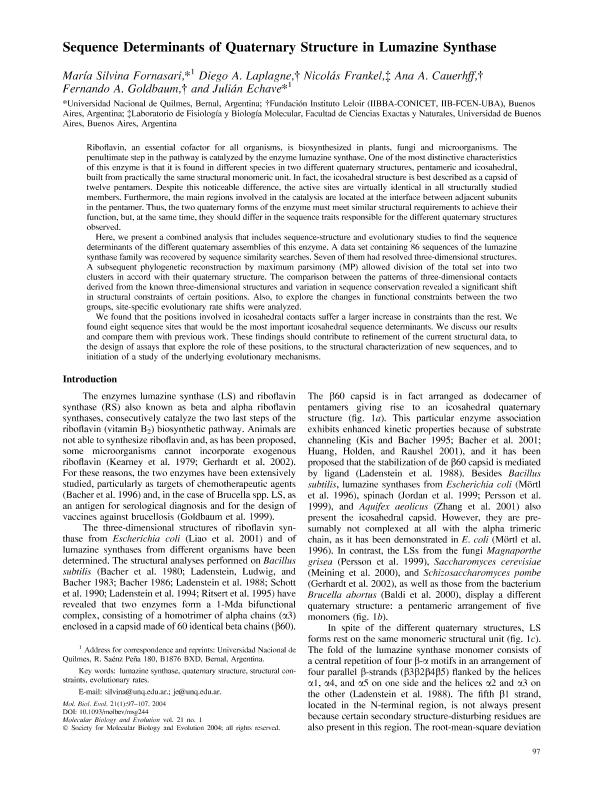Mostrar el registro sencillo del ítem
dc.contributor.author
Fornasari, Maria Silvina

dc.contributor.author
Laplagne, Diego Andres

dc.contributor.author
Frankel, Nicolás

dc.contributor.author
Cauerhff, Ana A.
dc.contributor.author
Goldbaum, Fernando Alberto

dc.contributor.author
Echave, Julián

dc.date.available
2018-04-23T18:44:42Z
dc.date.issued
2004-01
dc.identifier.citation
Fornasari, Maria Silvina; Laplagne, Diego Andres; Frankel, Nicolás; Cauerhff, Ana A.; Goldbaum, Fernando Alberto; et al.; Sequence Determinants of Quaternary Structure in Lumazine Synthase; Oxford University Press; Molecular Biology and Evolution; 21; 1; 1-2004; 97-107
dc.identifier.issn
0737-4038
dc.identifier.uri
http://hdl.handle.net/11336/43081
dc.description.abstract
Riboflavin, an essential cofactor for all organisms, is biosynthesized in plants, fungi and microorganisms. The penultimate step in the pathway is catalyzed by the enzyme lumazine synthase. One of the most distinctive characteristics of this enzyme is that it is found in different species in two different quaternary structures, pentameric and icosahedral, built from practically the same structural monomeric unit. In fact, the icosahedral structure is best described as a capsid of twelve pentamers. Despite this noticeable difference, the active sites are virtually identical in all structurally studied members. Furthermore, the main regions involved in the catalysis are located at the interface between adjacent subunits in the pentamer. Thus, the two quaternary forms of the enzyme must meet similar structural requirements to achieve their function, but, at the same time, they should differ in the sequence traits responsible for the different quaternary structures observed. Here, we present a combined analysis that includes sequence-structure and evolutionary studies to find the sequence determinants of the different quaternary assemblies of this enzyme. A data set containing 86 sequences of the lumazine synthase family was recovered by sequence similarity searches. Seven of them had resolved three-dimensional structures. A subsequent phylogenetic reconstruction by maximum parsimony (MP) allowed division of the total set into two clusters in accord with their quaternary structure. The comparison between the patterns of three-dimensional contacts derived from the known three-dimensional structures and variation in sequence conservation revealed a significant shift in structural constraints of certain positions. Also, to explore the changes in functional constraints between the two groups, site-specific evolutionary rate shifts were analyzed. We found that the positions involved in icosahedral contacts suffer a larger increase in constraints than the rest. We found eight sequence sites that would be the most important icosahedral sequence determinants. We discuss our results and compare them with previous work. These findings should contribute to refinement of the current structural data, to the design of assays that explore the role of these positions, to the structural characterization of new sequences, and to initiation of a study of the underlying evolutionary mechanisms.
dc.format
application/pdf
dc.language.iso
eng
dc.publisher
Oxford University Press

dc.rights
info:eu-repo/semantics/openAccess
dc.rights.uri
https://creativecommons.org/licenses/by-nc-sa/2.5/ar/
dc.subject
Lumazine Synthase
dc.subject
Quaternary Structure
dc.subject.classification
Otras Ciencias Químicas

dc.subject.classification
Ciencias Químicas

dc.subject.classification
CIENCIAS NATURALES Y EXACTAS

dc.title
Sequence Determinants of Quaternary Structure in Lumazine Synthase
dc.type
info:eu-repo/semantics/article
dc.type
info:ar-repo/semantics/artículo
dc.type
info:eu-repo/semantics/publishedVersion
dc.date.updated
2018-04-10T13:49:58Z
dc.identifier.eissn
1537-1719
dc.journal.volume
21
dc.journal.number
1
dc.journal.pagination
97-107
dc.journal.pais
Estados Unidos

dc.journal.ciudad
New York
dc.description.fil
Fil: Fornasari, Maria Silvina. Universidad Nacional de Quilmes; Argentina
dc.description.fil
Fil: Laplagne, Diego Andres. Consejo Nacional de Investigaciones Científicas y Técnicas. Oficina de Coordinación Administrativa Parque Centenario. Instituto de Investigaciones Bioquímicas de Buenos Aires. Fundación Instituto Leloir. Instituto de Investigaciones Bioquímicas de Buenos Aires; Argentina
dc.description.fil
Fil: Frankel, Nicolás. Universidad de Buenos Aires. Facultad de Ciencias Exactas y Naturales. Departamento de Fisiología, Biología Molecular y Celular. Laboratorio de Fisiología y Biología Molecular; Argentina
dc.description.fil
Fil: Cauerhff, Ana A.. Consejo Nacional de Investigaciones Científicas y Técnicas. Oficina de Coordinación Administrativa Parque Centenario. Instituto de Investigaciones Bioquímicas de Buenos Aires. Fundación Instituto Leloir. Instituto de Investigaciones Bioquímicas de Buenos Aires; Argentina
dc.description.fil
Fil: Goldbaum, Fernando Alberto. Consejo Nacional de Investigaciones Científicas y Técnicas. Oficina de Coordinación Administrativa Parque Centenario. Instituto de Investigaciones Bioquímicas de Buenos Aires. Fundación Instituto Leloir. Instituto de Investigaciones Bioquímicas de Buenos Aires; Argentina
dc.description.fil
Fil: Echave, Julián. Universidad Nacional de Quilmes; Argentina
dc.journal.title
Molecular Biology and Evolution

dc.relation.alternativeid
info:eu-repo/semantics/altIdentifier/url/https://academic.oup.com/mbe/article/21/1/97/1114672
dc.relation.alternativeid
info:eu-repo/semantics/altIdentifier/doi/http://dx.doi.org/10.1093/molbev/msg244
Archivos asociados
